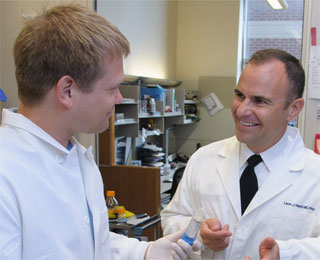
A National Institutes of Health (NIH) working group has issued a series of recommendations to boost dwindling numbers of clinicians trained as researchers. Findings of the Physician Scientist Workforce Working Group (PSW-WG) were presented before the NIH Advisory Committee to the Director on June 6. According to the group’s analysis, about 9,000 physician-scientists were in the NIH-funded workforce during the period of 2008 to 2012.
This included more than 4,100 individuals with an MD degree, as well as “4,086 with an MD/PhD, 341 nurse-scientists, 253 veterinarian-scientists, and 161 dentist-scientists,” according to the panel’s report.
The number of clinical researchers with medical degrees has remained fairly constant, despite steady overall declines in the biomedical workforce since the 1970s. Yet, the average age of the physician-scientist workforce has been on the rise, the report stated.
“There has actually been a small, but significant decrease in the total number of physician-scientists,” David Ginsburg, MD, co-chair of the PSW-WG, said in an interview. Ginsburg is an investigator at the Howard Hughes Medical Institute and is the James V. Neel Distinguished University professor at the University of Michigan Medical School’s Department of Human Genetics.
“However, we suspect that these numbers may decline more sharply as the workforce continues to age and is not being adequately replaced,” he said.
Aging of this workforce population isn’t the only problem; the work group observed that it also lacks diversity. African-Americans and Native Americans have been underrepresented among clinical researchers, as have female physician-scientists in some sectors of this NIH-funded workforce.
A number of challenges await physicians who want to pursue a career in research. Rising costs associated with the educational training in this field is one factor.
“Clearly, the difficult funding environment at the NIH is a major factor for physician-scientists, as it is for all scientists,” Ginsburg said. Physicians on average are about $200,000 in debt when they graduate; this is much more than a non-clinician scientist would accrue. “This exerts a lot of pressure to perform better-compensated clinical work,” he said.
Other complex economic factors are at play, such as dramatic changes within the healthcare system and in academic medical centers, he said.
Additionally, “the financial opportunities in practice offer an attractive option for clinically trained physician-scientists, who are also valuable as clinicians to academic medical centers, pulling them away from their investigative work and creating conflicting demands on time and energy,” the report stated.
Younger physician-scientists face their own struggles with attaining work/life balance and finding mentors who can guide them in their careers, while dealing with burdensome requirements to maintain their credentials.
To boost the physician-scientist workforce, the work group urged NIH to sustain robust support for MD/PhD training programs while taking steps to expand loan repayment programs. “The amount of loans forgiven should be increased to more realistically reflect the debt burden of current trainees,” the work group recommended.
The panel also suggested that NIH step up efforts to increase diversity in this workforce population and support pilot grant programs that would test ways to improve and shorten the length of research training.
In Ginsburg’s view, providing a new grant mechanism to bridge training and early career could be a key recommendation, “as well as the call for much more comprehensive followup/outcome data for all relevant NIH training/granting programs.”
NIH plans to give the working group’s report an extensive internal review. The expectation is that efforts will be made “to implement these recommendations wherever practical and appropriate,” Ginsburg said.